Category: Marketing

Marketing one-to-one is the latest way of developing marketing strategies, which involves practicing the highest level possible of personalization towards your customers. This high level of personalization is already being carried out by many companies through various channels, such as social media ads, email marketing, website personalization, and offline marketing.
By leveraging customer data and machine learning, marketing one-to-one enables companies to create personalized experiences that distinguish their brand from competitors and boost sales.
How to carry out Marketing one-to-one strategies?
To carry out marketing one-to-one strategies, data is fundamental. Once this data is obtained, it needs to be actionable. Here are four simple steps to follow:
-
-
- Know your customer: To develop this type of strategy, you need to know your customers’ preferences in terms of buying habits, content, and products. Collect every piece of data available for each customer, such as their demographics, purchase history, and engagement with your brand.
- Know your product: Like with customers, you need to know why each product is liked by each customer or why it isn’t, and what it can bring them.
- Know the effect of your campaigns: By analyzing historical data, you can determine the impact of each campaign on each of your customers and products.
- Develop original personalized content: Once you’ve analyzed customer and product data, you should be able to develop unique, appealing content for each customer depending on their wishes and needs.
-
What technology do I need to carry out a Marketing one-to-one Strategy?
To carry out marketing one-to-one strategies, a Customer Data Platform (CDP) is a critical technology for retailers. A CDP allows companies to store every piece of data related to customers, sales, campaigns, and any other useful data for your company’s purposes. With the help of artificial intelligence (AI), a CDP can cross-reference this data to obtain 360 profiles of your customers. These profiles, combined with AI, allow you to hyper-segment, personalize, and predict future behaviors of your customers.
An example of a Data-Driven Marekting one-to-one strategy
For example, if you are a fashion retailer, you can use the data mentioned before to understand your customers’ preferences, such as the size of your customer, the type of clothes they like, and the amounts of money they usually spend.
By analyzing customer behavior during specific events, such as special holidays or sales events, you can adjust your marketing campaigns to match their behavior. If a customer tends to buy multiple items during a particular event, you can recommend similar products or offer a discount for a bundle purchase. This type of personalized experience is what customers demand today, and it can lead to increased customer satisfaction and loyalty.
WHY FLYDE?
Do you want your company to move on to the next level? A CDP is the key tool that will allow you to maximize the potential of your data and grow your business. Having control over all your data is now very simple.
Moreover, if you do not have IT or Data Scientist teams, this tool will allow you to outsource this function. And if you have them but want to reduce their workload and give more autonomy to your marketing and business teams when it comes to working with data, implementing an easy-to-use CDP would be the best option for your company. It will allow any single member of your company to use it, as this softwares are prepared for them.
Start taking control of your data today.
Schedule a meeting with one of our experts and discover how FLYDE can help your company achieve its goals.
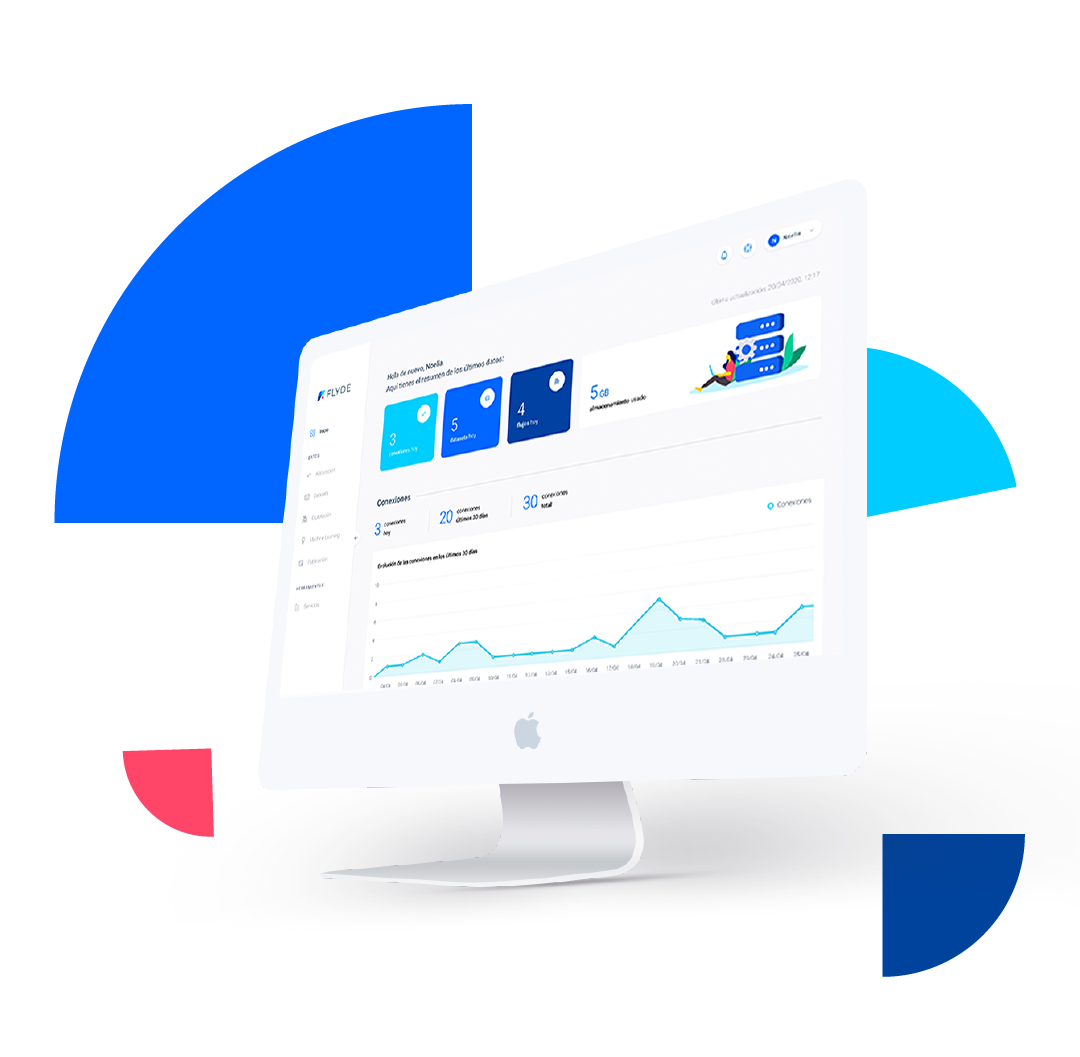
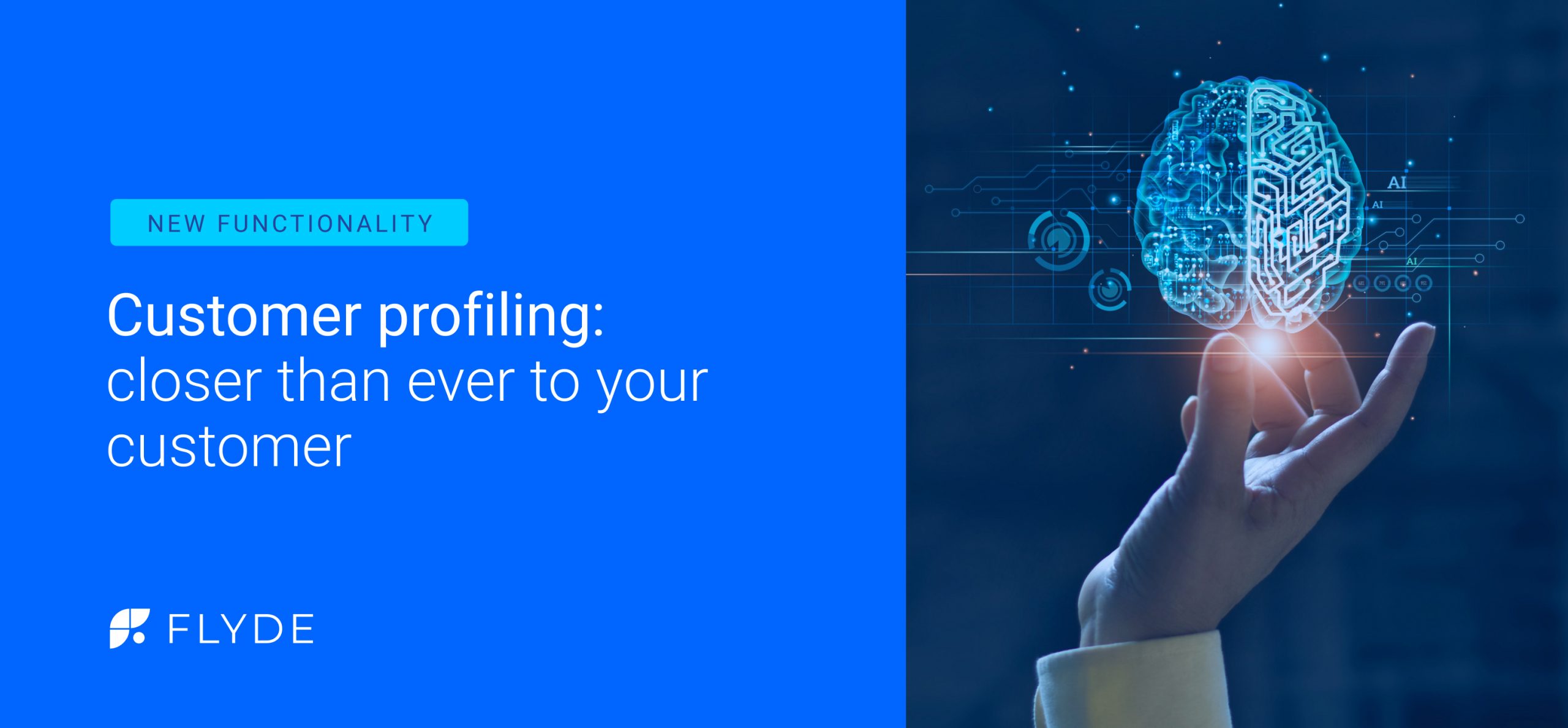
FLYDE is an easy-to-use Customer Data Platform designed to meet the needs of businesses looking to improve their customers’ experience, increase retention, ROI, ROAS, and Customer Engagement.
In this blog, we will discuss the new functionality of the platform: Customer Profiling guided by predictive AI models.
What is customer profiling?
Customer profiling is a tool that allows businesses to better understand their customers and tailor their offerings to meet their specific needs. With FLYDE’s customer profiling, businesses can select a product from their catalog and see the main characteristics of the customers who purchase it. Predictive AI models evaluate all available data your company has on your customers such as their behavior, purchase patterns, product preferences, browsing habits, and more.
How does FLYDE’s customer profiling work?
Suppose a company has a product in its catalog and wants to better understand its precise customers to adapt its marketing strategy. With FLYDE, the company can select that product and use predictive AI models to identify the main characteristics of the customers who purchase it. For example, the models may reveal that customers who buy that product earn more than €40,000, log into the ecommerce page twice a week, and often make purchases in physical stores.
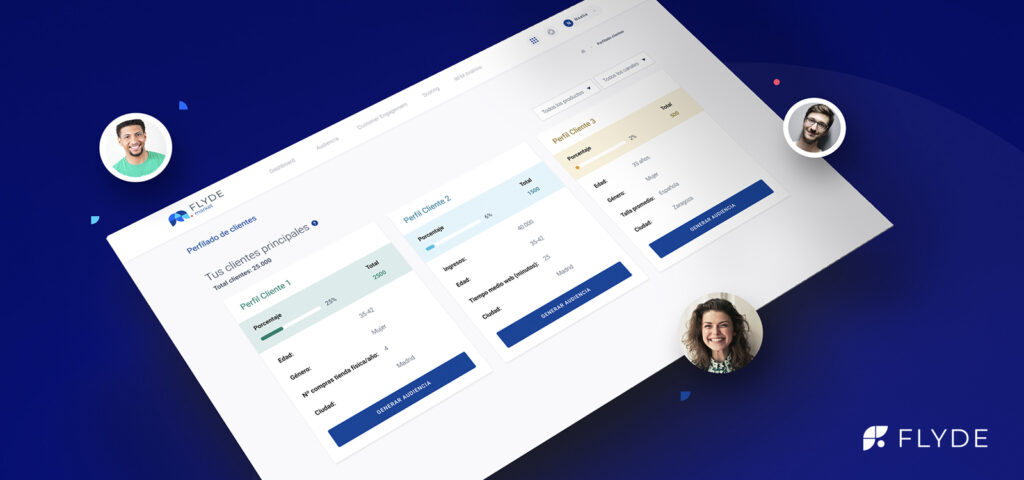
How can customer profiling improve your marketing strategy?
Predictive AI-guided customer profiling can significantly improve your marketing strategy by allowing you to better understand your customers and tailor your offerings to their specific needs. By using this new functionality of FLYDE, you can personalize your marketing messages to meet the specific needs and desires of your customers.
Additionally, customer profiling also allows you to improve the segmentation of your marketing campaigns. By better understanding your customers and grouping them into segments based on their characteristics, you can personalize your messages and offers for each specific segment. This will allow you to reach your customers with more relevant messages, increasing the likelihood of conversion to sales.
Identifying new potential customers with Customer Profiling
In addition to helping you better understand your current customers, FLYDE’s customer profiling also allows you to identify new potential customers. The platform’s AI uses the purchase behavior data of your current customers to find patterns and similarities between them.
These patterns help you identify new business opportunities by finding potential customers who have a similar profile to your current customers. By understanding your customers’ preferences and behaviors, you can use that information to reach a wider audience that is more likely to buy your products or services.
With FLYDE’s customer profiling, you can discover new market segments that may not have been on your radar and adjust your marketing strategy to reach them more effectively. This can result in a higher return on investment and increased customer loyalty.
Why FLYDE
Do you want your company to move on to the next level? A CDP is the key tool that will allow you to maximize the potential of your data and grow your business. Having control over all your data is now very simple.
Moreover, if you do not have IT or Data Scientist teams, this tool will allow you to outsource this function. And if you have them but want to reduce their workload and give more autonomy to your marketing and business teams when it comes to working with data, implementing an easy-to-use CDP would be the best option for your company. It will allow any single member of your company to use it, as this softwares are prepared for them.
Try it for free with our free trial (with auto-generated fake data)!
Start taking control of your data today.
Schedule a meeting with one of our experts and discover how FLYDE can help your company achieve its goals.

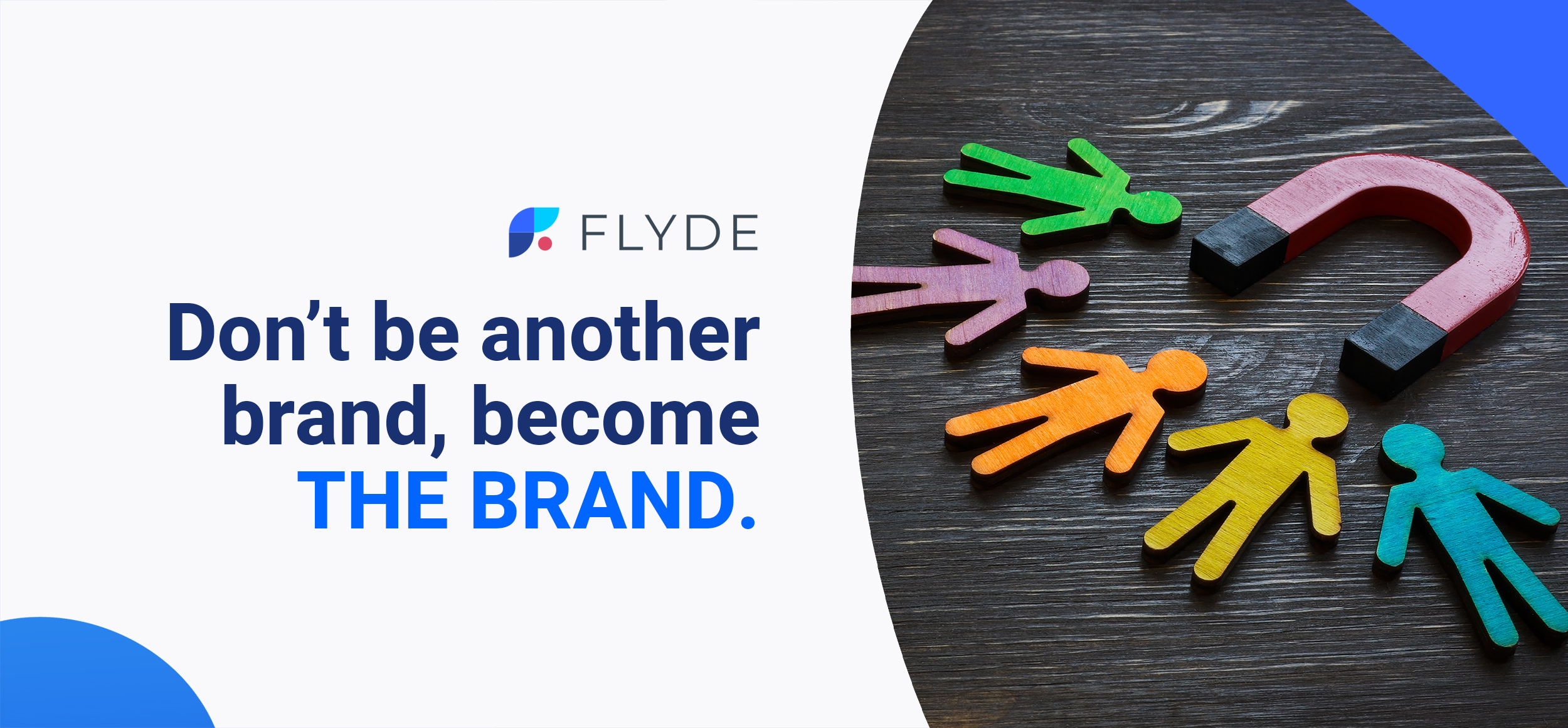
As the world becomes increasingly competitive, companies must focus on customer satisfaction and loyalty to succeed. While customer acquisition is essential for growth, customer retention is even more critical. Retaining existing customers is essential for the long-term health of any business, as loyal customers tend to spend more, refer more, and cost less to retain.
In this blog, we will discuss marketing retention vs. acquisition and why current trends show that retention is much more important. We will also explore how a Smart Customer Data Platform (CDP) can help companies boost retention.
The importance of Customer Retention
The cost of acquiring new customers is significantly higher than retaining existing ones. According to a study by Harvard Business Review, increasing customer retention by just 5% can increase profits by 25-95%. This is because loyal customers tend to spend more, refer more, and cost less to retain.
Additionally, loyal customers provide valuable feedback and can help businesses improve their products and services. Therefore, it is essential for companies to focus on retaining existing customers.
Customer Retention vs. Customer Acquisition
While customer acquisition is necessary for growth, it should not come at the expense of customer retention. Many companies make the mistake of focusing too much on acquiring new customers and neglecting existing ones. However, research shows that companies that focus on customer retention tend to be more successful in the long run. Customer retention should be a top priority for any company that wants to grow and thrive.
The benefits of focusing on retention over acquisition
Focusing on customer retention over acquisition can provide a number of benefits to companies, including increased customer lifetime value (CLV), improved customer loyalty, and reduced marketing costs. By retaining existing customers, companies can increase CLV by encouraging repeat purchases and reducing churn. Additionally, loyal customers tend to refer others to the company, which can help reduce marketing costs associated with customer acquisition. By prioritizing retention, companies can create a positive cycle of growth that leads to long-term success.
How a Smart CDP can help boost retention
A Smart CDP can provide a comprehensive view of a company’s customers, allowing them to personalize marketing messages, improve customer service, and identify opportunities to upsell and cross-sell.
For example, let’s say a retailer collects data on a customer’s purchase history, browsing behavior, and preferences. With a Smart CDP, the retailer can use this data to send targeted marketing messages based on the customer’s interests and behavior. They can also use the data to recommend complementary products, provide personalized promotions, and improve customer service by addressing the customer’s specific needs and concerns. By using a Smart CDP, the retailer can create a more personalized and engaging experience for their customers, which can lead to increased loyalty and retention.
WHY FLYDE?
Do you want your company to move on to the next level? A CDP is the key tool that will allow you to maximize the potential of your data and grow your business. Having control over all your data is now very simple.
Moreover, if you do not have IT or Data Scientist teams, this tool will allow you to outsource this function. And if you have them but want to reduce their workload and give more autonomy to your marketing and business teams when it comes to working with data, implementing an easy-to-use CDP would be the best option for your company. It will allow any single member of your company to use it, as this softwares are prepared for them.
Start taking control of your data today.
Schedule a meeting with one of our experts and discover how FLYDE can help your company achieve its goals.

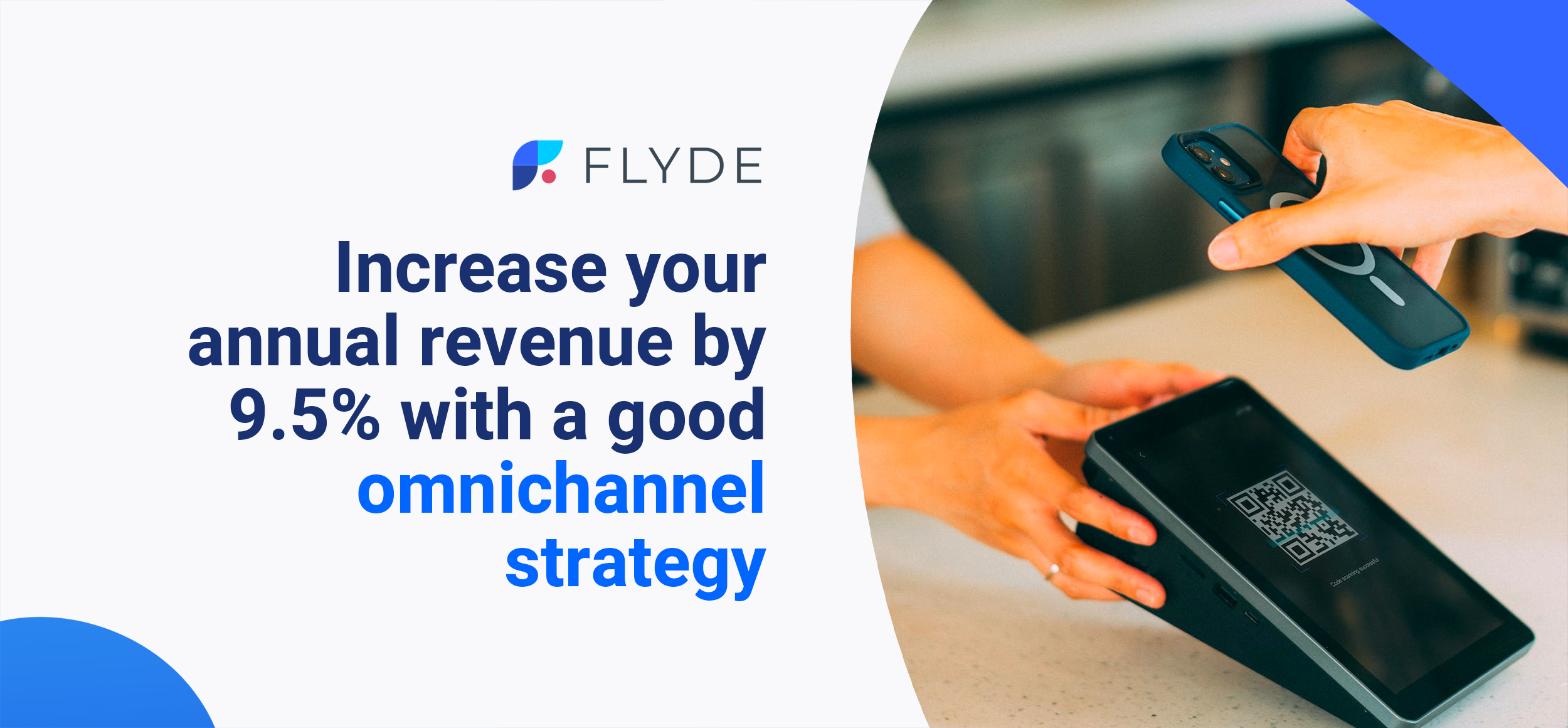
According to Harvard Business Review, 73% of consumers use multiple channels throughout their purchase process.
In today’s digital age, customers expect seamless, personalized experiences across all channels. To meet these expectations, companies need to implement omnichannel marketing strategies that integrate all of their marketing channels. However, this can be challenging without the right tools and technology.
In this blog, we’ll explore the benefits of omnichannel marketing for companies and how a customer data platform (CDP) can help make it easier and more effective.
How to Create Omnichannel Customer 360 Profiles
To create omnichannel customer 360 profiles, companies need to aggregate and unify customer data from all sources. This includes online and offline interactions, such as purchases, website visits, social media engagement, and in-store interactions. A CDP can help with this by ingesting data from various sources, cleaning and deduplicating it, and stitching it together into a single, comprehensive customer profile.
Once the data is integrated into the CDP, the company can start building out the 360-degree view of each customer. This involves mapping out each customer’s interactions across different channels, tracking their preferences and behavior, and segmenting them based on attributes such as demographics, purchase history, and engagement.
How to Obtain Insights from Customer 360 Profiles
Once a retailer has created omnichannel customer 360 profiles, they can start leveraging the insights to improve their customer experience. A CDP, as well as ingesting and structuring data, can be used to obtain insights, with the different tools that conform this type of platforms.
One way to obtain insights from customer 360 profiles is to use real-time personalization. By leveraging the data in the CDP, retailers can create personalized experiences for each customer based on their preferences and behavior. This can include personalized product recommendations, targeted promotions, and customized messaging.
Applying Artificial Intelligence with a Smart CDP
AI can be used to analyze large volumes of customer data and uncover insights that might not be apparent from manual analysis. For example, AI-powered predictive analytics can be used to anticipate customer needs and preferences, as well as identify opportunities for cross-selling and upselling.
Another way to apply AI to customer 360 profiles is through machine learning. By training machine learning models on customer data, retailers can automate tasks such as product recommendations and content personalization, as well as improve the accuracy of predictive analytics.
Summary
Creating omnichannel customer 360 profiles with a CDP is a critical step for retailers looking to provide personalized, seamless experiences across all channels. By leveraging AI-powered analytics and personalization, retailers can gain valuable insights from these profiles and use them to improve the customer experience. So, if you’re a retailer looking to enhance your customer engagement, consider implementing a CDP and start creating omnichannel customer 360 profiles today.
WHY FLYDE?
Do you want your company to move on to the next level? A CDP is the key tool that will allow you to maximize the potential of your data and grow your business. Having control over all your data is now very simple.
Moreover, if you do not have IT or Data Scientist teams, this tool will allow you to outsource this function. And if you have them but want to reduce their workload and give more autonomy to your marketing and business teams when it comes to working with data, implementing an easy-to-use CDP would be the best option for your company. It will allow any single member of your company to use it, as this softwares are prepared for them.
Start taking control of your data today.
Schedule a meeting with one of our experts and discover how FLYDE can help your company achieve its goals.

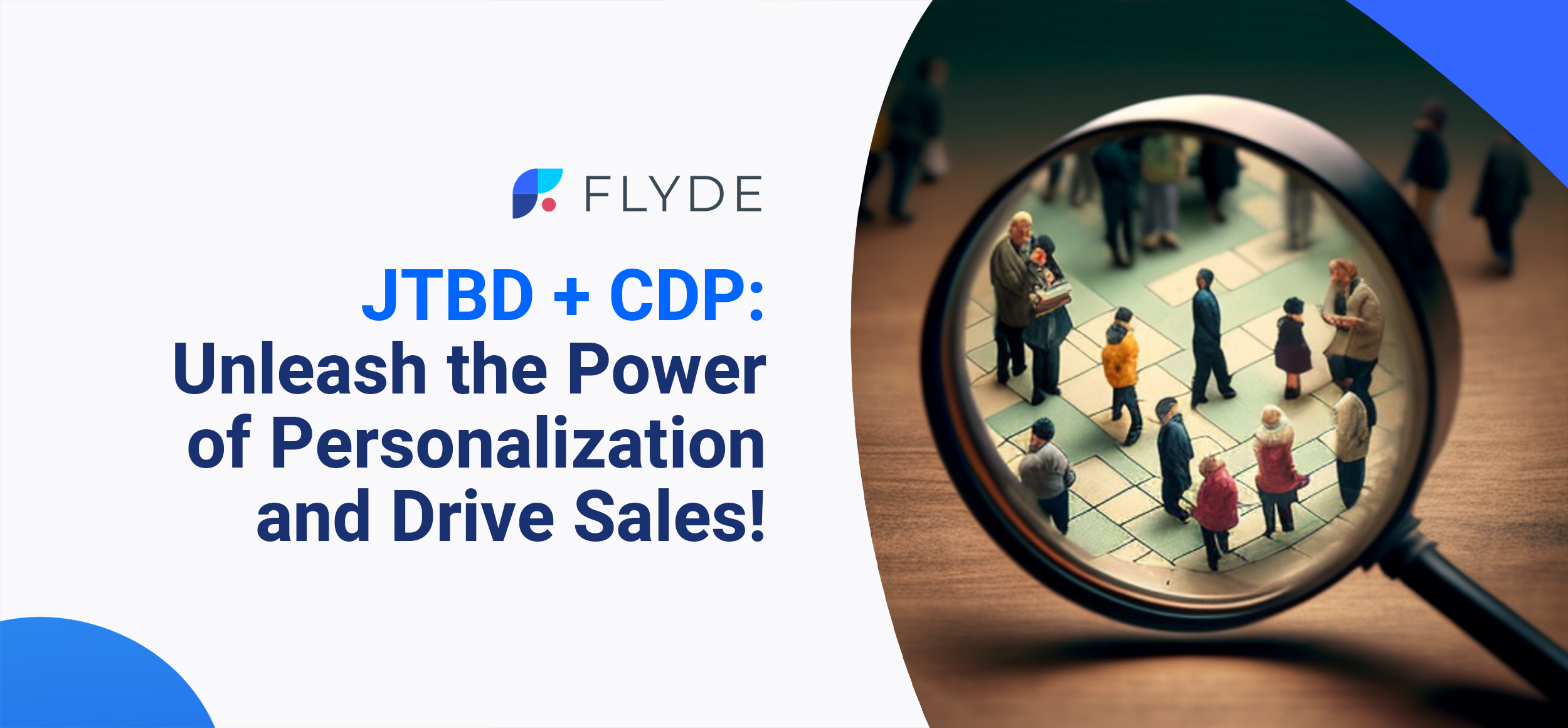
Understanding your customers’ needs and desires is essential to building a successful business. However, it’s not enough to simply ask your customers what they want. To truly understand their needs, you must identify the jobs or tasks they are trying to accomplish. This is where the Jobs-To-Be-Done (JTBD) framework comes in.
In this blog, we’ll see how to improve your JTBD strategy with a Customer Data Platform (CDP). By using a CDP, you can gain a more comprehensive understanding of your customers and their behaviors, which can help you improve your JTBD strategy.
Why Understanding JTBD Is Crucial for Your Business
Jobs-To-Be-Done (JTBD) is a framework that helps businesses understand the needs and desires of their customers by focusing on the jobs or tasks that customers are trying to accomplish. By understanding your customers’ JTBD, you can design products and services that meet their needs and differentiate yourself from competitors.
How to Improve Your JTBD Strategy with a CDP
A Customer Data Platform (CDP) is a data management tool that allows you to collect, unify, and analyze customer data from multiple sources. By using a CDP, you can gain a more comprehensive understanding of your customers and their behaviors, which can help you improve your JTBD strategy.
Here are four ways to improve your JTBD strategy with a CDP:
-
-
-
- Collect and unify customer data from multiple sources: A CDP allows you to collect and unify customer data from multiple sources, giving you a more comprehensive view of your customers.
- Analyze customer data using the JTBD framework: Using the JTBD framework, you can analyze customer data to identify the specific jobs your customers are trying to accomplish.
- Personalize marketing and product recommendations: By using the CDP to personalize your marketing and product recommendations, you can better meet your customers’ JTBD and increase engagement and sales.
- Optimize inventory to better meet customer needs: By understanding your customers’ JTBD, you can optimize your inventory to better meet their needs, reducing waste and improving your bottom line.
-
-
Case Study – How could a retailer improve their JTBD strategy with a CDP?
A retailer uses a CDP to collect and unify customer data from multiple sources, enabling them to gain a comprehensive view of their customers and their behaviors. Using the JTBD framework, the retailer analyzes the data to identify the specific jobs their customers are trying to accomplish when they shop for clothes, such as looking for stylish and fashionable clothes, prioritizing comfort and functionality, or finding clothes for specific occasions.
The retailer uses the CDP to personalize their marketing and product recommendations to better meet their customers’ JTBD. By creating targeted email campaigns and personalized product recommendations, the retailer increases customer engagement and sales, leading to higher customer loyalty and repeat purchases.
Additionally, the retailer is able to optimize their inventory to better meet their customers’ needs, reducing waste and improving their bottom line. In this way, using JTBD and a CDP can help fashion retailers to better understand their customers and improve their business results in a highly competitive industry.
Conclusion and Next Steps
In conclusion, understanding your customers’ JTBD is essential to designing products and services that meet their needs. By using a CDP to collect, unify, and analyze customer data, you can gain a deeper understanding of your customers and improve your JTBD strategy. To get started, consider implementing a CDP and using the four strategies outlined in section two to improve your JTBD strategy. With a more customer-centric approach, you can differentiate yourself from competitors and build stronger, more loyal customer relationships.
WHY FLYDE?
Do you want your company to move on to the next level? A CDP is the key tool that will allow you to maximize the potential of your data and grow your business. Working like the big multinationals in the market, which already have this type of software, and having control over all your data is now very simple.
Moreover, if you do not have IT or Data Scientist teams, this tool will allow you to outsource this function. And if you have them but want to reduce their workload and give more autonomy to your marketing and business teams when it comes to working with data, implementing an easy-to-use CDP would be the best option for your company. It will allow any single member of your company to use it, as this softwares are prepared for them.
Start taking control of your data today.
Schedule a meeting with one of our experts and discover how FLYDE can help your company achieve its goals.

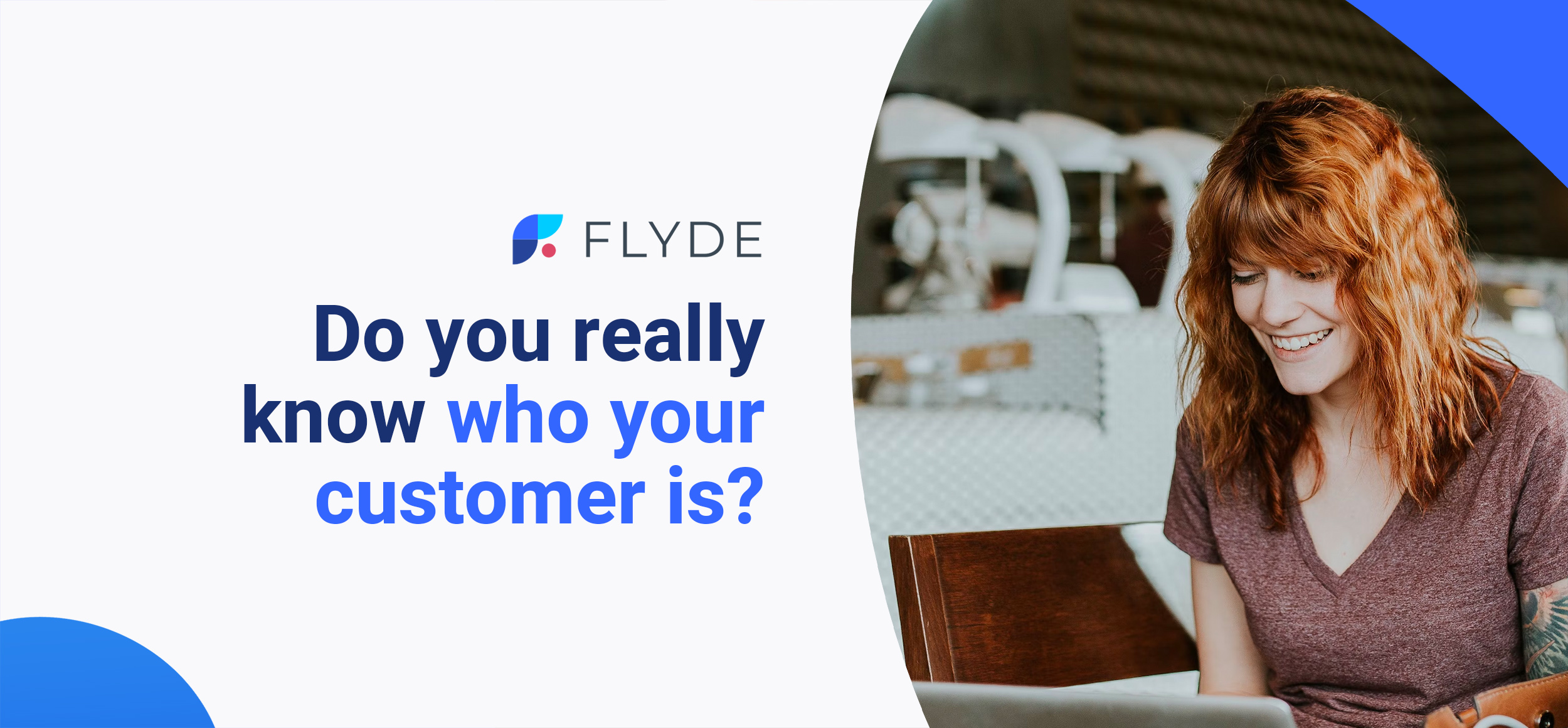
If you’re looking for a way to better understand your customers and their purchasing behavior, RFM analysis is an excellent place to start. This powerful tool allows you to segment your customer base based on recency, frequency, and monetary value, giving you valuable insights into the behavior of different groups of customers.
What is RFM Analysis?
RFM analysis is a data-driven approach to customer segmentation. By analyzing customer data in terms of Recency (how recently they made a purchase), Frequency (how often they make purchases), and Monetary value (how much they spend), you can gain insights into the behavior of different groups of customers.
How Does RFM Analysis Work?
To perform RFM analysis, you need to collect data on your customers’ purchase history, including the date of their last purchase, the number of purchases they’ve made, and the total amount they’ve spent. You can then rank customers on each of these metrics and assign them a score between 1 and 5 for each metric.
For example, a customer who made a purchase in the last week would be assigned a high score for recency, while a customer who hasn’t made a purchase in several months would be assigned a low score. Similarly, a customer who has made many purchases and spent a lot of money would be assigned a high score for frequency and monetary value, while a customer who has made only a few purchases and spent little money would be assigned a low score.
Once you’ve assigned scores to each customer, you can use these scores to segment your customers into different groups based on their behavior. For example, you might have a group of high-value customers who make frequent purchases, a group of low-value customers who make infrequent purchases, and a group of recent customers who haven’t yet made a lot of purchases.
How Can You Use RFM Analysis to Improve Your Business?
Once you’ve segmented your customers using RFM analysis, you can use this information to tailor your marketing and sales strategies to each group.
For example, you might create different types of content or promotions to target each group.
If you have a group of high-value customers who make frequent purchases, you might focus on providing them with personalized offers and promotions. You might also consider creating a loyalty program to reward them for their continued business.
If you have a group of recent customers who haven’t yet made a lot of purchases, you might focus on providing them with educational content that helps them understand the value of your products or services. You might also consider offering them a special promotion to incentivize them to make a purchase.
By using RFM analysis to segment your customers and tailor your marketing and sales strategies to each group, you can improve your overall customer retention and satisfaction, which can ultimately lead to increased revenue and growth for your business.
Which martech tool would be needed to carry out RFM analysis properly?
By using a Customer Data Platform (CDP) you could effectively perform RFM analysis. A CDP is a software tool that allows you to collect, analyze, and segment customer data from multiple sources, including your website, social media channels, customer support interactions, or any other that you might have.
To perform RFM analysis using a CDP, you first need to integrate your customer data into the platform by connecting your website analytics tool, email marketing platform, CRM system, and any other database with customer information that you have available to the CDP. Once integrated, the CDP will automatically assign scores to each customer based on their behavior in terms of Recency, Frequency, and Monetary value.
Using the insights gained from RFM analysis, you can segment your customers into different groups and tailor your marketing and sales strategies to each group. By using a CDP to perform RFM analysis, you can gain a more comprehensive understanding of your customers’ behavior, make informed business decisions, and improve your overall performance.
WHY FLYDE?
Do you want your company to move on to the next level? A CDP is the key tool that will allow you to maximize the potential of your data and grow your business. Working like the big multinationals in the market, which already have this type of software, and having control over all your data is now very simple.
Moreover, if you do not have IT or Data Scientist teams, this tool will allow you to outsource this function. And if you have them but want to reduce their workload and give more autonomy to your marketing and business teams when it comes to working with data, implementing an easy-to-use CDP would be the best option for your company. It will allow any single member of your company to use it, as this softwares are prepared for them.
Start taking control of your data today.
Schedule a meeting with one of our experts and discover how FLYDE can help your company achieve its goals.


Christmas can be the toughest or happiest time of the year for marketeers. The time when sales boost or not showing your marketing’s strengths or weaknesess.
In this blog we are not going to tell you how to become a millionaire nor are we going to explain how to easily become a Christmas hero, our sole purpose is to explain how using data you can drive a proper Christmas marketing strategy.
Data-driven marketing
Base your strategy on data and not intuition. Make sure your KPIs are SMART, can be mapped correctly with the tools you have, and make sure you are not missing key customer data.
At Christmas in particular knowing your customers would be fundamental to drive one-to-one marketing strategies, basic data is fine, but if you have a lot more available use it:
You can track your customer across all your online channels. This will help you to map their Customer Journey. If you already have a tagging tool such as FLYDE’s, then you may be interested to know that you can unify this data with offline data (from physical shops or offline marketing campaigns), and in turn with socio-demographic data, thus obtaining a 360-degree view of your customer.
First-Party Data Strategy
This data is known as first-party data, and you should start using it, firstly, because of the loss of third-party cookies, and secondly, because of the amount of data and possibilities you are missing out on.
Of those data sources we discussed, the spectrum is even greater. Not only is it essential to collect data from all sources, but going one step further in the data you collect can make a fundamental change to your strategy.
By collecting attitudinal and behavioural data, such as the number of times a customer looks at a product before buying it, or their interest in the themes of your offline and online campaigns, or whether they buy for themselves or as a gift (depending on the variability of sizes they are looking for). You will be able to enrich this customer database in order to generate campaigns and strategies that are not based on intuition but on data, thus avoiding failures or recriminations to the marketing team.
Platform to obtain Actionable Insights from first-party data
All this data must come together to bring value to your company, without this unification the data lacks the real value it can achieve. To do this, there is a type of platform that surpasses CRM because it not only allows you to store basic data but also allows you to store large volumes of data or Big Data, and to act on them within the platform itself with Artificial Intelligence processes. This Platform is a Customer Data Platform.
All this will allow your company to have all this structured data, to segment, personalise and predict with countless variables. As we have previously explained, 360º customer profiles open up these new possibilities.
Customer data platform for Christmas
And back to the initial question, how can I save my Christmas campaign with this CDP stuff? You can’t, a CDP doesn’t do magic, nor does Big Data or Artificial Intelligence despite what it seems lately with the boom of this technology.
A CDP or Customer Data Platform is not going to do marketing for you, what it will do is become the fundamental support for your company. Because as we have been seeing for a few years now, the customer must be at the centre of every company, and without a CDP this is not really possible.
So a marketing team that has all the data at its fingertips will be a marketing team that will no longer ask itself why this campaign didn’t work and the previous one did? With data you will get certainty.
You will be able to make predictions about the type of campaign that will work at any given time of the year based on how each campaign has affected your customers. So if I want to launch a campaign at Christmas, I will be able to compare by type of campaign and by date, with those previously carried out, to see the expected performance based on the data; a calculation that increases exponentially its accuracy and simplicity if you have a predictive model like the ones FLYDE has available.
Later, once you have launched the campaign in your CDP, you will be able to track your KPIs and compare them to see where the success or failure has been, where there has been a change with respect to the previous one, what to improve and what to maintain. As we have said throughout the article, a CDP is not going to do marketing for you, but it can help you stop making mistakes and start relying on data.
WHY FLYDE?
Do you want your company to move on to the next level? A CDP is the key tool that will allow you to maximize the potential of your data and grow your business. Working like the big multinationals in the market, which already have this type of software, and having control over all your data is now very simple.
Moreover, if you do not have IT or Data Scientist teams, this tool will allow you to outsource this function. And if you have them but want to reduce their workload and give more autonomy to your marketing and business teams when it comes to working with data, implementing an easy-to-use CDP would be the best option for your company. It will allow any single member of your company to use it, as this softwares are prepared for them.
Start taking control of your data today.
Schedule a meeting with one of our experts and discover how FLYDE can help your company achieve its goals.


2022 has been a key year for Customer Data Platforms. According to data provided by Deloitte, high growth brands are leading this change, with 61% moving to a first-party data strategy, while just 41% of low-growth brands are doing so.
The prohibition of third-party cookies and the obligation to use own data or customers who demand increasingly personalized experiences are some of the reasons that have driven this growth, which is expected to continue in 2023.
But what else can we expect? Here are 4 trends that will shape CDPs in 2023:
1. Increased adoption of CDPs by companies
Omnichannel strategies
The arrival of COVID-19, the new ways of buying (ROPO, Showrooming), or the constant raise of online buying, are some of the causes of the increased need of companies to develop omnichannel strategies, in order to unify their channels and their customer data through the whole brand.
Customers demand a better customer experience
Communication and generalized customer treatment is a thing of the past. Customer experience has positioned itself as a key factor for customers to stay with a brand or abandon it to the point where 86% of consumers would be willing to pay more if it meant a better and more personalized customer experience.
Obtaining relevant insights from Customer Data
Personalization and digital transformation also means receiving much larger amounts of data from our customers. Therefore, it becomes necessary to have a system that stores, organizes and processes data properly.
2. The Customer Data Platform (CDP) concept takes hold and is divided into subcategories.
While it is true that there are markets such as the U.S. where this type of platform is already well established, there are others where CDPs are just beginning to gain momentum.
At the moment, according to the CDP Institute’s Member Survey 2022, more than 60% of clients understand that the main functionalities of this type of platform are unified views of clients and the loading of data from different sources.
The year 2023 is expected to serve as a turning point and leave behind doubts about what these platforms are, what they do and how they can help a company. In the same way, it is estimated that a greater expansion of the knowledge of these platforms and their benefits will help the implementation in companies to understand how they can fit them into their MarTech strategies.
It is also expected that vendors will begin to differentiate into subcategories (pure data, analytics and campaigns) to help customers quickly identify capabilities and benefits.
3. Increased concern for data privacy
41% of consumers globally say their trust in digital service providers’ ability to keep personal data secure has decreased. By storing data in a Platform regulated under the strict GDPR protection will ensure a much safer environment for Customer’s Data.
We know how important it is to protect your customers’ data. That’s why at FLYDE we comply with legal and data protection obligations. You can find out how here.
4. Easy to use CDP platforms
The complexity of analyzing large amounts of data from different sources and processing them has made most of the CDP platforms on the market very technical. While it is true that there are companies with large IT teams, we can also find others in which the burden of these actions falls on teams with little technical knowledge that make it very difficult to use these tools properly.
Some suppliers are opting to facilitate some of the tools that make up their platforms, although there is still a long way to go as these changes require time and investment. However, it is still important: CDP platforms are becoming more and more transversal to all company departments. Sharing unified profiles, sharing data, cross-referencing and processing them in real time or generating strategies from them are just some of the common processes that we can find in any company on a daily basis.
For this reason, marketing and sales professionals, among other departments, are looking for greater autonomy when generating campaigns, cross-referencing data, etc., and thus avoiding funnels and waiting times.
WHY FLYDE?
Do you want your company to move on to the next level? A CDP is the key tool that will allow you to maximize the potential of your data and grow your business. Working like the big multinationals in the market, which already have this type of software, and having control over all your data is now very simple.
Moreover, if you do not have IT or Data Scientist teams, this tool will allow you to outsource this function. And if you have them but want to reduce their workload and give more autonomy to your marketing and business teams when it comes to working with data, implementing an easy-to-use CDP would be the best option for your company. It will allow any single member of your company to use it, as this softwares are prepared for them.
Start taking control of your data today.
Schedule a meeting with one of our experts and discover how FLYDE can help your company achieve its goals.


A Customer Data Platform is a global platform so many departments from many sectors can benefit from it. In fact every single department of the company Customer-Related will end up making the most of it.
As many different departments would use it, it is crucial for it to be accessible. This is why an easy-to-use CDP is vital for a company to be able to become Customer-Centric. Start taking control of your Data.
Customer-Centric Data-Driven Companies
Becoming Customer-Centric is a priority for companies, as U.S. companies lose $136.8 billion per year due to avoidable consumer switching. The current competition for market share has become more fierce than ever before, and the need to become omni-channel, forced companies who were willing to become Customer-Centric to be Data-Driven, in order to understand such amounts of Customers Data.
This is where Customer Data Platforms fit into place. A Customer Data Platform is a Platform where you store and unify all of your customers data (1st, 2nd, and 3rd Party Data), and with the use of AI/ML obtain actionable insights, from your customer’s 360 profile.
We would next see the different benefits a CDP would provide to the different departments of a company:
Marketing Teams
- 360 Profile: unifying customer data in one platform and in real time, enables a complete customer profile, that can be afterward compared with the rest of customers/potential customers to obtain insights.
- Hyper Segmentation: the unification of basic, behavioral, attitudinal, and socio-demographic data would enable a level of segmentation never seen before. Segmenting by buying habits for example (ROPO, Showrooming, etc.).
- Personalization: with the 360 profiling of customers your company could start personalizing campaigns according to each customers needs (Personalized newsletters, emails, content in Social Media depending on your customers segment presence, etc.).
- Predictive models on the efficiency of each campaign on each customer: a CDP will help your company on predicting tendencies with AI/ML. One thing your marketing team could do is by adding up your past campaigns to your 360 customers profile, predict the future campaigns efficiency, by types of campaigns and by customers likes.
- Buyer Personas in real time: having your customer data unified and constantly renewing would enable a constant buyer persona of each product, or a picture of the personal characteristics of the preferred customer for each product.
- Omni-channel Customer Journeys: each channel of communication works different, but customers demand a full unified experience from brands. You would be able to track the customer journey through channels to activate a personalized omni-channel experience
- Forget about Third-Party Cookies: a tagging functionality in a CDP would help you track each individual customer through your website and add this information to their 360 profile.
- Geomarketing: unifying 3rd Party-Data (Socio-demographic) allow the 360 profile to be much more detailed. With this you would be able to see the differences between neighborhoods, seeking for the one that matches the most with your buyer persona, ML algorithms would help you on this task, in order to show you the best neighborhoods to sell each product.
- Dynamic Scoring: model that gives a rating from 1 to 10 of each individual’s customer engagement in real time, to see how campaigns are affecting them or the point they are at with your company in terms of engagement.
- Orchestrate campaigns: get the insights from your customers and afterword the CDP would enable you to orchestrate campaigns by sending this audiences, segments or profiles on to your different tools (email marketing, Social Media, advertising group, etc.).
Sales Teams
- Personalized Contact: contacting via email or phone with customers or potential customers is really tough but it would definitely be easier if your sales team had a 360 Profile (with the unification of 1st 2nd and 3rd party data) to have all of the information from your customer (behavioral, attitudinal, basic, etc.) while you do phone sales.
Logistic Operators
- Demand forecast models: being able to predict the demand with efficiency rates over a 95% would avoid stock outs.
Directors
- Full reports easy to read: in the same platform and with all of the data and insights obtained before you would be able to extract reports, graphs, and summaries of how your company is performing in terms of customer experience.
- Demand forecast models: know a year before the total demand your company would have in order to organize properly financially.
WHY FLYDE?
Do you want your company to move on to the next level? A CDP is the key tool that will allow you to maximise the potential of your data and grow your business. Working like the big multinationals in the market, which already have this type of software, and having control over all your data is now very simple.
Moreover, if you do not have IT or Data Scientist teams, this tool will allow you to outsource this function. And if you have them but want to reduce their workload and give more autonomy to your marketing and business teams when it comes to working with data, implementing an easy-to-use CDP would be the best option for your company. It will allow any single member of your company to use it, as this softwares are prepared for them.
Start taking control of your data today.
Schedule a meeting with one of our experts and discover how FLYDE can help your company achieve its goals.

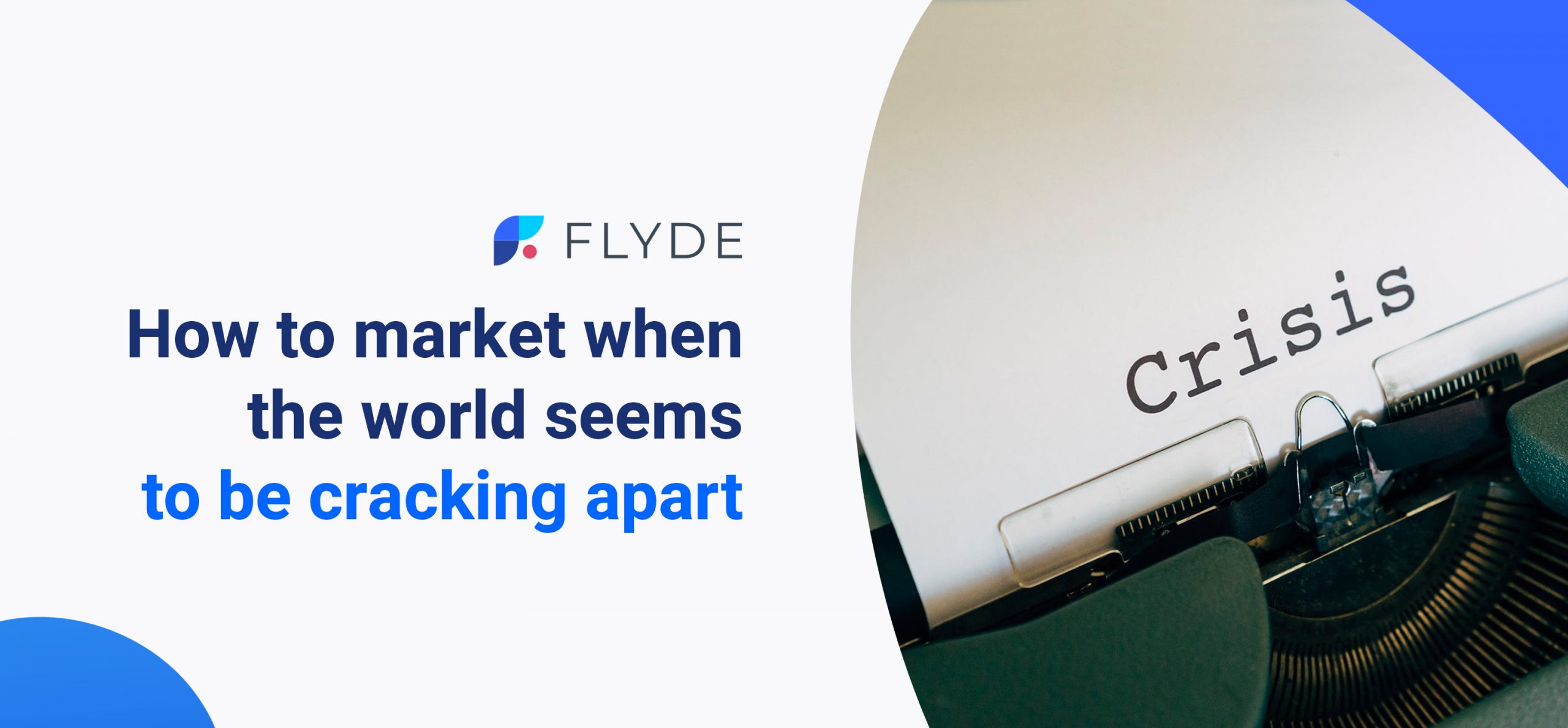
It seems obvious that an economic downturn is coming. How does this affect on Marketing strategies, and what can those marketing teams do to minimize the damages of an economic downturn?
In this article we would explain how through the correct use of Customer Data you could optimize your resources in order to minimize damages of an economic downturn.
Current Situation
After the global pandemic, the war and at the high inflation rates that western countries are facing, it seems quite obvious that we are facing an economic contraction. We are quite experienced with this type of situation after 2008, but our current possibilities to face it are different from those we had in 2008.
Today, we have new solutions that could help our company be one of those companies that suffer the least out of the recession. The adoption of Artificial Intelligence and Big Data helps every department of companies to develop data-driven strategies, really useful especially in time where your company would need to gain efficiency against your competitors. The problem comes for those companies that aren’t yet implementing this type of solutions, as their techniques are becoming obsoletes.
In this article we will focus on the main problems and possible solutions that a Marketing team could be facing in this situation.
How does an economic downturn affect marketing teams?
Budget Cuts
When economic contractions start, companies tend to lower down each department’s budget, but as seen always, marketing budget tends to be the most affected one. When the marketing budget is noticeably cut your strategies would surely suffer, and what is more important, your customers tend to realize this, which would end resulting on loosing customers.
Lack of purchasing power from customers
Economic recessions affect on every single member of the society and your customers would not escape from it. Your customers won’t be able to continue spending as before and they would start choosing more wisely where to spend their money. Competence would start becoming more fierce as the demand would decrease, so your ability to overcome your competitors must be better than ever.
Higher prices for resources
Inflation, and specially in the current situation, raises up the prices paid by your company to produce goods or services. So margins become much smaller, and marketing gets much more complicated, offers and discounts need to be measured to the nearest, and prices can’t raise up for a weaker experience as customers would notice and leave your company for your competitors.
Loosing Customers
It’s the moment where you lose customers and it’s 7 times more expensive to gain a new customer than to retain one. As we have seen in the points described before, loosing customers is a typical thing in economic downturns, this can suppose a complete breakdown to a company as loosing customers is the most expensive matter for a company.
The need for companies to retain customers and gain unhappy customers from their competitors goes through boosting your marketing efficiency, and your customer experience, in order to lead the market in an uncertain moment.
How can marketing teams face economic downturns?
Know where to cut off by knowing your customers
Cuts in budget are going to happen, the crucial point resides in knowing where to make those cuts so that customers don’t realize it. With the use of an Intelligent CDP you would be able to track your customers journey to know where and what they expect from your company. With this analysis done you would be able to cut off just the thing you where doing and that affected the least to your customers.
Stock management with demand forecast to optimize resources
Big Data and Artificial Intelligence bring unlimited opportunities for companies. Your company could start to know and understand your customer to the extent of being able to forecast your customer’s next movement. In this way with the historical data and Machine Learning, you would be able to have predictions of demand up to a 95% or above preciseness on the demand of each product, and each customer.
With this detail of forecast you would be able to reduce to minimums losses or surpluses of stock, saving huge amounts of money for the company.
Offers and discounts depending on each individual situation
Attitudinal segmentation, know which customers are looking for offers and which ones are not in order to prioritize discounts and maintain those customers. By tracking your customers attitudinal and behavioral contacts with your company, you would be able to know if they are looking for discounts or not, in this way you would optimize your marketing strategies, and use your budget more wisely.
WHY FLYDE?
Do you want your company to move on to the next level? A CDP is the key tool that will allow you to maximise the potential of your data and grow your business. Working like the big multinationals in the market, which already have this type of software, and having control over all your data is now very simple.
Moreover, if you do not have IT or Data Scientist teams, this tool will allow you to outsource this function. And if you have them but want to reduce their workload and give more autonomy to your marketing and business teams when it comes to working with data, implementing an easy-to-use CDP would be the best option for your company. It will allow any single member of your company to use it, as this softwares are prepared for them.
Start taking control of your data today.
Schedule a meeting with one of our experts and discover how FLYDE can help your company achieve its goals.

